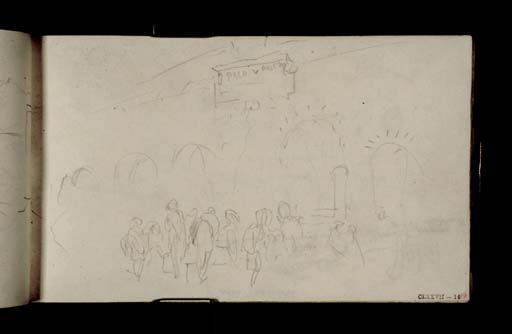Joseph Mallord William Turner Figures at a Fountain, beside the Aqueduct between Recanati and Loreto 1819
Image 1 of 2
Joseph Mallord William Turner,
Figures at a Fountain, beside the Aqueduct between Recanati and Loreto
1819
Joseph Mallord William Turner 1775–1851
Folio 16 Recto:
Figures at a Fountain, beside the Aqueduct between Recanati and Loreto 1819
D14683
Turner Bequest CLXXVII 16
Turner Bequest CLXXVII 16
Pencil on white wove paper, 110 x 186 mm
Inscribed by the artist in pencil ‘PALO V PONT MAX’ within top of aqueduct
Inscribed by John Ruskin in red ink ‘16’ bottom right
Stamped in black ‘CLXXVII 16’ bottom right
Inscribed by the artist in pencil ‘PALO V PONT MAX’ within top of aqueduct
Inscribed by John Ruskin in red ink ‘16’ bottom right
Stamped in black ‘CLXXVII 16’ bottom right
Accepted by the nation as part of the Turner Bequest 1856
References
1909
A.J. Finberg, A Complete Inventory of the Drawings of the Turner Bequest, London 1909, vol.I, p.521 as ‘Figures at a fountain (?)’.
1984
Cecilia Powell, ‘Turner on Classic Ground: His Visits to Central and Southern Italy and Related Paintings and Drawings’, unpublished Ph.D thesis, Courtauld Institute of Art, University of London 1984, p.408, as ‘The aqueduct between Recanati and Loreto, with an inscription to Paul V (at a point 3 km. from Loreto), and figures at the fountain beside it’.
After visiting the city of Loreto, Turner’s route took him south-west towards Recanati, a small hill town approximately three miles away. Cecilia Powell has identified this sketch as part of the aqueduct which stretches across the valley between the two locations and which supplied water from the mountains until the eighteenth century. Built by Giovanni Fontana and Carlo Maderno the aqueduct and a series of underground tunnels were installed to service the needs of the large number of pilgrims who travelled to Loreto every year to visit the Shrine of the Holy House. At a point on the present-day Via Archi near a bus stop approximately two miles outside of Loreto, the remains of the aqueduct bearing an inscription commemorating its construction can still be seen today. The full text reads as follows:
PAVLO V PONT MAX QVOD OPTIMI PRINCIPIS PROVIDENTIA AQVA EX | AGRO RECINETENSI PVRISSIMIS EX FONTIBVS OPERE | SVBTERRANEO ET ARCVATO IN VRBEM LAVRETANAM | DVCTA EST | SCIPIO S.R.E. CARD BVRGHESIVS DOMVS LAVRETANAE | PROTECTOR MONVMENTVM POSVIT | AN MDCXX PONTIFIC XVI
The artist has inscribed the first words only, noting that the aqueduct was built during the papacy of Paul V (1552–1621). In the foreground of the sketch are a group of figures are crowded around a fountain beneath the arches. The fountain no longer exists, but as James Hamilton has noted, it would have made a convenient watering place for travellers on the road to or from Loreto.1
Turner registered the existence of the aqueduct in the Italian Guide Book sketchbook as part of his summary of information from Eustace’s A Classical Tour through Italy, 1815 (see Tate D13939; Turner Bequest CLXXII 4a). He also annotated in situ the relevant passage in his copy of Reichard’s Italy, 1818, noting that the surviving structure contained ‘33 arches’ (see Tate, Turner Bequest CCCLXVII, p.332). Further sketches can be found on folios 11 verso, 12 verso, 14 verso, 15 verso, 16 verso (D14674, D14676, D14680, D14682 and D14684).
An aqueduct appears as a feature in the middle distance of the finished oil painting, The Loretto Necklace exhibited 1829 (Tate, N00509).2 However, Turner has used considerable artistic licence in its depiction, placing it to the north of the city instead of the south, and representing it with a double rather than a single row of arches.
Nicola Moorby
November 2008
How to cite
Nicola Moorby, ‘Figures at a Fountain, beside the Aqueduct between Recanati and Loreto 1819 by Joseph Mallord William Turner’, catalogue entry, November 2008, in David Blayney Brown (ed.), J.M.W. Turner: Sketchbooks, Drawings and Watercolours, Tate Research Publication, December 2012, https://www


